This article does not cite any sources .(April 2014) (Learn how and when to remove this template message) |
Lachik is a Kachin sub-tribe. It has its own language/dialect. The sub-tribes are Rawang, the Lisu, the Zaiwa, the Lashi/Lachik, the Lawngwaw and Jingpo. A group of seven sub-tribes call Kachin (Wunhpawng).

The peoples of Kachin, more precisely known as Jingpho Wunpong or simply Wunpong, are a confederation of ethnic groups who inhabit the Kachin Hills in northern Myanmar's Kachin State and neighbouring Yunnan Province, China, and Arunachal Pradesh, India. About one million Kachin peoples live in the region. The term Kachin people is often used interchangeably with the main subset, called the Jingpo people in China.
The Rawang people are an ethnic group who inhabit far northern Kachin State of Burma (Myanmar). There are one D'rung family and several Anung families found among Lisu tribe people in Arunachal Pradesh in India. However, Nung rawang people and Anung (Lisu) people are two different groups. Anung people speak and write in their own language. The Anung population mixed with Lisu tribe people in China is estimated about 20000. According to cultural research and their own oral traditions, the Nung-Rawang are most likely Mongolian descendants who moved south from the Mongolian steppes to the 3 river region of China. During the second millennium, the Nung-Rawang migrated south west into the Himalayas at the top of Burma, seeking fertile farm lands. They settled in some of the most remote valleys and mountains in all of Burma. The Nung-Rawang are a proud, peaceful, industrious, agriculturally based mountain people known for their stability, hospitality, and colourful traditions. Living in the beautiful and isolated regions of northern Burma, they have also become prosperous through the plentiful supplies of jade and gold in their region. During the British colonial period, their very existence was thought to be a myth, as incoherent reports of "pygmy tribes" in the mountains of north Burma surfaced from time to time. The Drung, a sub tribe of the Nung-Rawang are short in stature, and are known for their crossbow hunting skills, and an extensive anthropological study has been initiated on this remote ethnic group by Dr. P. Christiaan Klieger of the California Academy of Sciences, since 2001.
The Lisu people are a Mongo - Lo Lo ethnicc group who inhabit mountainous regions of Burma (Myanmar), southwest China, Thailand, and the Indian state of Arunachal Pradesh.
The majority of Lachik people live in northern Burma's Kachin State and bordering areas between Myanmar and China.

Myanmar, officially the Republic of the Union of Myanmar and also known as Burma, is a country in Southeast Asia. Myanmar is bordered by India and Bangladesh to its west, Thailand and Laos to its east and China to its north and northeast. To its south, about one third of Myanmar's total perimeter of 5,876 km (3,651 mi) forms an uninterrupted coastline of 1,930 km (1,200 mi) along the Bay of Bengal and the Andaman Sea. The country's 2014 census counted the population to be 51 million people. As of 2017, the population is about 54 million. Myanmar is 676,578 square kilometres in size. Its capital city is Naypyidaw, and its largest city and former capital is Yangon (Rangoon). Myanmar has been a member of the Association of Southeast Asian Nations (ASEAN) since 1997.

China, officially the People's Republic of China (PRC), is a country in East Asia and the world's most populous country, with a population of around 1.404 billion. Covering approximately 9,600,000 square kilometers (3,700,000 sq mi), it is the third- or fourth-largest country by total area. Governed by the Communist Party of China, the state exercises jurisdiction over 22 provinces, five autonomous regions, four direct-controlled municipalities, and the special administrative regions of Hong Kong and Macau.










